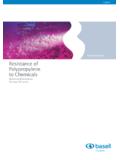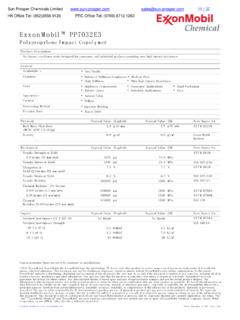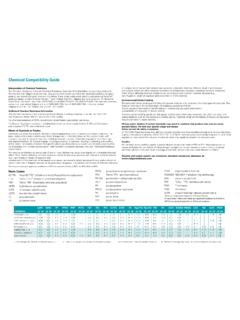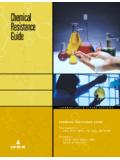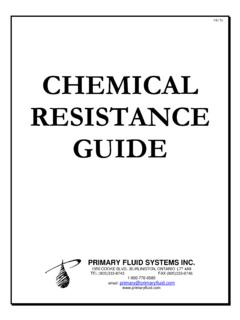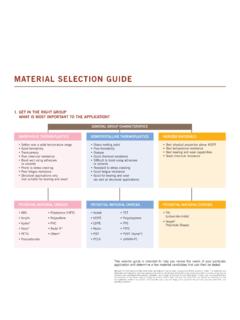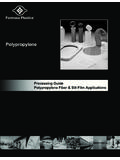Transcription of about: polypropylene - IPS Flow Systems
1 252about: polypropyleneGeneral properties of polypropylenePolypropylene exhibits thermal stability up to 100 C (short-term 120 C for drainage Systems ). polypropylene also showsgood impact strength, improving further along withincreasing temperature. polypropylene is physiologically non-toxic (in accordancewith ONORM B5014, Part 1, FDA, BGA, and KTW guidelines)making it ideally suited for a piping material in contact withpotable important advantages of polypropylene are:-Low specific weight of long term creep resistance-Excellent chemical resistance-High resistance to thermal ageing-Outstanding welding characteristics-Excellent abrasion resistance-Smooth internal surfacesCharacteristicsChemical resistanceThe chemical resistance of polypropylene is consideredexcellent.
2 It is resistant to dilute (aqueous) solutions of salts,acids and alkalis and to a large number of organic is resistant to concentrated hydrochloric acid andhydrofluoric acid, however above certain concentration levelsdiffusion can occur. This does not damage the material itself butit can cause secondary damage to surrounding steelconstructions. In this type of application, double containmentpiping Systems have been found ideally suited. Note: PP-R and Copper:Direct contact between PP-R and copper, especially at highertemperatures, can lead to deterioration of the physicalproperties of PP-R.
3 Heat ageing is faster due to the acceleratedthermal resistancePiping Systems in beige grey polypropylene are not UVstabilised, and therefore they should be suitably protectedagainst degradation when used outdoors - especially wherethere are high UV levels. Protection against direct solar radiationcan be achieved by the application of a UV absorbent coatingsuch as AGRU Coat, or by adding a layer of insulation. It is alsopossible to compensate for the surface damage that may ariseby increasing the wall thickness of the piping system. In suchcases, the additional wall thickness should be not less than2mm.
4 As polypropylene does not contain light stable colourpigments, it may experience a change of colour (fading) becauseof long-term characteristicsPolypropylene is non-conductive, therefore Systems will remainfree from electrolytic corrosion. Precautions should be taken toavoid static discharge should any part of a polypropylene pipingsystem pass through an area where explosive gases may characteristicsPolypropylene piping Systems from IPS are physiologically non-toxic (in accordance with ONORM B5014, Part 1, FDA, BGA,and KTW guidelines) making them ideally suited as a pipingmaterial in contact with potable (PP) is a thermoplastic from the polyolefin group of materials.
5 Ithas low density compared to other thermoplastics, and a unique combinationof properties including mechanical strength, chemical resistance and are two different types of polypropylene that are in common use aspiping materials:PP-H (Homopolymer)PP-R (Random copolymer)The pipes, sheets and semi-finished products supplied by IPS aremanufactured from nucleoid PP-H 100 (Beta -PP), whilst fittings areproduced from PP-R ( polypropylene random copolymer). polypropylene generally exhibits a good resistance against a variety ofchemicals, such as salts, acids, and alkalis. Good chemical resistance is alsoachieved against contact with solvents, such as alcohols, esters and , solvent cement welding of polypropylene pipes and fittings isnot are a number of welding techniques suitable for pressure piping applications.
6 High quality, reliable joints can be achieved usingsocket fusion jointing, butt fusion welding, non-contact Infra-Red (IR) butt welding, and electrofusion welding. In addition, polypropylene Systems can be joined using flanges, threaded connections and mechanical piping Systems are available from IPS in metric dimensions according to DIN 8077/8078 and DIN of polypropylene (Average values) Strength30 MPa25 MPaElongation at Break>300%>300%Notched Impact Strength at 23 C 50 kJ/ m225 kJ/ m2 Notched Impact Strength at -30 C 5 kJ/ m22 kJ/ m2 Modulus of Elasticity1300 MPa900 MPaCoefficient of Linear C CMaximum Operating Temperature 90 C90 CMinimum Operating Temperature-10 C-10 CCrystalline Melting Temperature160-165 C150-154 CMelt Flow g/10min Resistance>1013 >1013 Thermal W/m K W/m KFlammabilityHB UL94HB UL94 Colour - Beige Grey7032 RAL7032 RALIPS Flow Systems l Seaham Grange Industrial Estate l Seaham l SR7 0PT l England l Tel: 0191 521 3111 l.
7 PolypropylenePressure ratings for polypropylene systemsMaximum continuous pressure ratingsPipes, fittings and valves are designed to operate continuously for 50 years at their maximum rated pressure at 20 C as follows,unless otherwise pressure ratings for polypropylene pipes according to DIN 8077 & DIN 8078 and polypropylene fittings according to DIN 16962are defined by the nominal pressure method,wherebypipes, fittings and valves are grouped together according to a single nominalpressure rating. The PN rating is the maximum permitted operational pressure in bars calculated at 20 C, for example PN6 indicatesa maximum working pressure of 6 bars.
8 According to this method the pressure ratings of polypropylene pipes and fittings accordingto the nominal pressure system is as follows:-Jointing polypropylene SystemsPP pipe to pipe and pipe to fitting joints are easy to make, using socket fusion, butt fusion or electrofusion equipment is available for sale or hire - see Tools and Installation installation instructions, as well as free training, is available on PartsHeatingFinished JointIndividual PartsHeatingFinished JointIndividual PartsHeatingFinished JointIndividual PartsHeatingFinished JointSocket FusionButt FusionInfra-Red (IR) FusionElectro-FusionSize RangeMax. Operating PressureFittingsSocket Fusion PN10 20mm to 110mm10 BarSpigot Fusion PN10 20mm to 500mm10 BarPN650mm to 1000mm6 to BarThreadedPN101/4 to 4 10 BarSize RangeMax.
9 Operating PressurePipePN16 10mm to 225mm16 BarPN10 16mm to 500mm10 BarPN620mm to 710mm6 BarPN440mm to 1000mm4 50mm to 63mm to BarStandard Dimensional Ratio (SDR) Standard Dimensional Ratio (SDR) is used to define thermoplastic pipes in a variety of materials including polypropylene ,polyethylene, and PVC-U. Taken from ISO 4065, SDR is described as being the ratio of the nominal outside diameter of a pipe to itsnominal wall thickness . To calculate the SDR according to ISO 4065 the following equation can be used:SDR =dewhere:SDR = Value to be calculatede = Thickness of the pipe wall (mm)d = Pipe outside diameter (mm)edSDR = d/eIPS Flow Systems l Seaham Grange Industrial Estate l Seaham l SR7 0PT l England l Tel: 0191 521 3111 l





